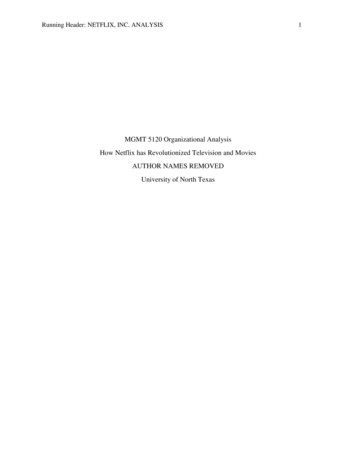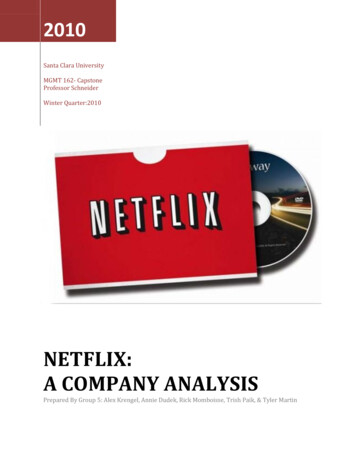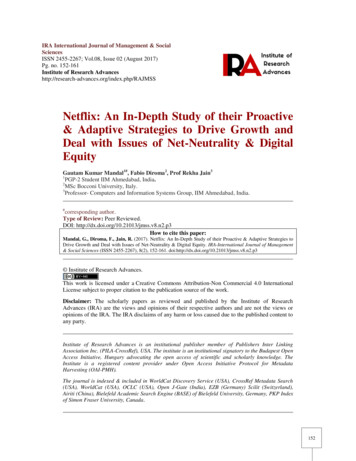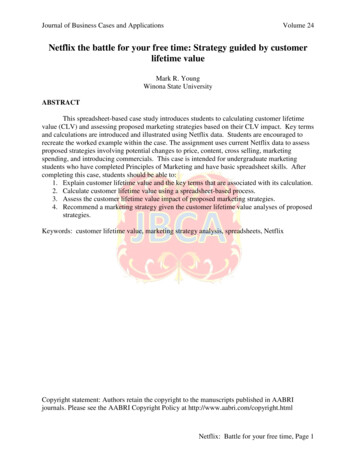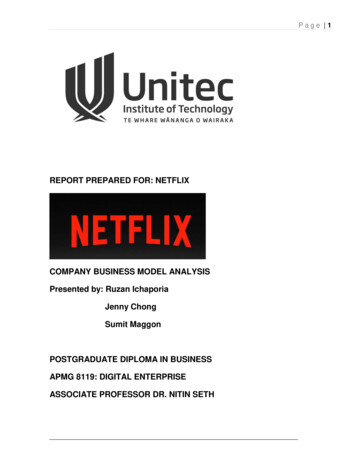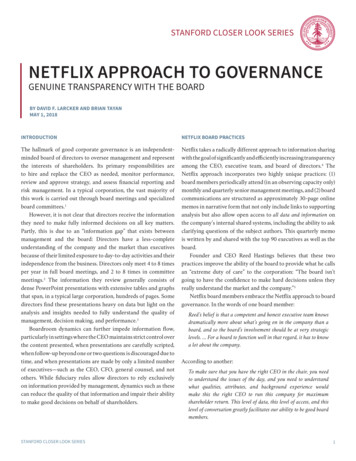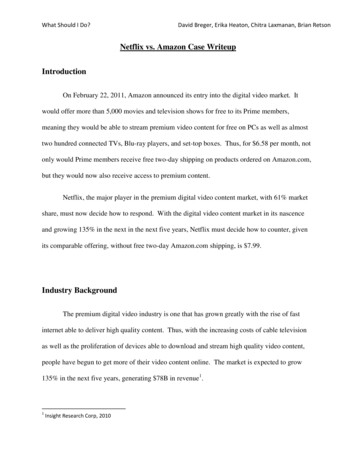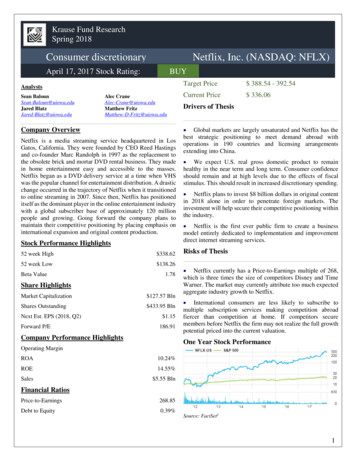
Transcription
XMBA 2013Netflix Strategic AnalysisGlobal Strategic ThinkingJoey M. Reed, XMBA 20134/17/2013
EXECUTIVE SUMMARYIn 1999, Reed Hastings launched an online movie rental service called, “Netflix.” The companystarted as an online subscription business that allowed consumers to rent movies and televisionshows. This service allowed for fast access to movies and television shows and challenged tonorm of watching television via networks and DVD rentals. Netflix’s core business model issubscriptions. Consumers are allowed to rent or stream video entertainment by subscribing withNetflix for a monthly subscription rate. The rental model provided fast distribution of DVDrentals delivered to the person’s home faster and less expensive than competitors. The rentals didnot have a return policy that dictated ‘when’ the consumer has to return the DVD. A rental canbe held as long as they wish and returned when the person wished to rent another DVD. DVDswere shipped with no delivery fees, late fees, or pay per view fees. A return envelope for prepaidshipping was provided for ease of return. Streaming is also offered and capable for instantviewing of content through devices that had streaming capabilities. Subscribers (prior to 2011)paid one subscription price for both.During 2011, the company changed its subscription strategy to separate the rental and streamingmodels. This backfired and consumers reacted by self-selecting out. Netflix’s CEO publiclyapologized and changed the subscription policy back to a consolidated subscription price. Thisimpacted the company’s stock price invoking analyst’s skepticism over the company’s strategy.The company continues to be challenged with recovering from the switch in pricing strategies.Netflix has forecasted quarterly losses during 2012 due to losses in its international segment.Growth is expected in domestic streaming by 10-12 percent within target forecasts. Investorreactions to the company’s forecast and growth strategies were negative. Stock had risen to 129per share and then dropped dramatically to a low of 72.49.STRATEGIC FRAMEWORKNetflix provides a platform for consumers to watch movies and television. It has a subscriptionbased business model and three customer segments that it serves. DVD-by-Mail: Serves subscribers who opted to receive movie and TV episode DVDs bymail.Streaming: Provides instant watching capabilities to subscribers who wish to stream contenton their content enabled devices.The customers that Netflix serves are defined as those who like the convenience of homedelivery and/or instant streaming, bargain hunters who were focused on cheap prices, and movieenthusiasts who want access to a broader selection. In order to meet the needs of the customersand increase market share as the market leader, Netflix has formulated a strategic approachwhich includes the following: Comprehensive library of moviesAcquiring new content by deepened relationships with providersIncreasing the ease of use for subscribers to place content into queuesProvide a choice between stream or mailed rentalsAggressive marketing expendituresPage 1
Influence transition from mail to streamingExpand internationallyINDUSTRY EVALUATIONNetflix competes in the entertainment sector. Specifically, the company provides services formovies and videos. This industry has a highly competitive environment.DRIVING FORCES Consumer preferences including rentals, video-streaming, and other entertainment choices Advancement of new technology drives product offerings and purchasing platforms. New ecommerce companies and internet companies seek to provide services. Legislative laws and regulations guide industry standards for operations. Movie production and other television companies provide content for product or serviceoffering.KEY SUCCESS FACTORSIn order to be successful in this industry, a company should have competencies in the followingfactors: Expertise in technology and being able to be flexible as well as agile in a shorter cycle oftechnology industry. Development of a strong distribution channel with a high level of accessibility to directconsumers. Breadth of product or service lines to meet a wide variety of tastes and personal interests. Strong marketing position and brand name. Excellent consumer support and satisfaction. Fast assistance and delivery systems. Supply chain management capabilities including relationships with content providers andexpertise in contract negotiation. Strong ecommerce capabilities. Strong financial position.PORTERS FIVE FORCESCompetition among rivalry is High: There are many competitors from a wide variety ofcapabilities through the internet, stand-alone rental stores, cable and television networks.Threat of substitutes is High: There are many options in which to choice from for entertainmentand content through various media channels such as networks, movie theatres, and the internet.Threat of new entrants is High and Moderate: New and existing internet companies and appsare being developed to enable users to view movies and content. Networks are testing thecapabilities of providing their own streaming. Online streaming has lower barriers to entry incosts to start and availability as well as cost of content. If the entrant is seeking a stand-alonerental company, the threat is moderate due to capital costs and the costs to building appropriateinventory.Page 2
Bargaining power of suppliers is High: Suppliers have bargaining power due to ownershiprights of content and movie/copyright laws. Suppliers can control the timing of the release ofcontent and videos. Suppliers can select licenses between a various competitors. Competitors inthis industry are reliant upon the ability to provide movies and content to its customersBargaining power of buyers is High: Customers have several competitors to choose from andother preferences on their disposable income. Switching costs are low and the ease of switchingis high between competitors.COMPETITORS AND STRATEGY MAPPING 10 9 7.99 8Monthly Fees 7 6.58 6 7.99 520,00060,000 6 415,000 317,000 2 1 0010,00020,00030,00040,00050,00060,00070,000Number of TitlesThe industry has some fierce players which include Google, Redbox, Amazon, Disney’s Hulu,Walmart’s VuDu, Blockbuster, Apple’s iTunes, and other cable or network companies.According to the strategy map, Netflix (red) sets itself apart with its number of titles available. Itholds approximately 3 times more titles than its competitors (Hulu: 7.99, Amazon: 6.58, andVuDu: 6) for similar monthly fees.INDUSTRY ATTRACTIVENESSThe growth of technology and changes in consumer entertainment habits are becoming moremobile. This is in line with the shift from home or office based technology products such astelevisions and PCs. Trends in more mobile devices such as iPods, iPads, tablets, and otherandroid systems allow the opportunity for the consumer to view content via wireless internetanytime and anywhere. Netflix has the opportunity to defend its market share and capture moresubscribers. However, the cost of content makes the company vulnerable to large and upfrontcapital needs.Page 3
COMPANY EVALUATIONSWOT nal expansionAlliances with adjacentcompaniesExploit emergingtechnologiesThreatsTitle SelectionWeak or Suspect StrategiesPiracyCustomer BaseReputation IssuesFast DeliveryWeak Financial ForecastEase of UseAlliances with technologyproductsHigh Marketing/Rev CostsIncreased competitionHigh Churn RateSubstitute productsWide geographic coverageErosionShift in buyer preferenceInternational BusinessLearning CurveVulnerability to supplierdemands & costsLegal Copyright LawsInvestor/Analyst SkepticCOMPETENCIESCore Competency: Providing customers easy access to movies and television content.Distinctive Competency: Offering a large selection of choices in a subscription based model.Competitive Advantage: Convenience of delivery, instant streaming, and no late or return feesfor rentals and streaming.VALUE CHAINLicenses with content andmovie producersAgreements withtechnology hardwareMarketingContracts with DVDprovidersDistribution Centers &Mail tionNetflix is primarily involved with the marketing, administration, and providing the viewingcapabilities to its customers. The content and movies are provided through contracts, licenses.The hardware of online streaming is provided by technology manufactures and agreements aremade to make Netflix’s applications available or easily downloaded. Mail facilities are externaland distribution centers are integrated. The major costs for Netflix are incurred through thelicenses and contracts with the movie producers and DVD providers to distribute the service toits customers. This is also prevalent when entering into the global market. As of 2011, Netflixhas streaming content obligations due over the course of 5 years in the amount of 3,907.2 mil.Page 4
FINANCIAL ANALYSISFinancially, the company has had a positive history with its profitability. The following ratiosshow the historical ratios and the company has reported a 10-12 percent rate of growth.20052007200920102011Profitability RatiosGross Profit Margin32%35%35%37%36%Net profit Margin6%6%7%7%7%Total Return on Assets10%7%17%18%8%Return on Stockholder Equity19%16%58%55%35%Earnings per Share79%99%205%306%428%Current Ratio1.82.11.81.61.5 106.1 223.5 190.1 248.6 605.8Liquidity RatiosWorking CapitalSurprisingly, the pricing strategy change did not impact the company’s profitability. Its grossprofit margin is healthy at approximately 36%, net profit margin is consistent at 7%, earnings pershare increased. Its liquidity ratios indicate the company is able to hold sufficient assets to payfor its liabilities and has an increasing working capital balance.The following table shows a comparison of the company’s contribution costs per segment andhow the company has allocated its costs of revenues and marketing.Number of SubscribersContribution ProfitCosts per SubscriberTotal costs & marketing shareDomesticStreaming23,410,000 2.84 18.0058%InternationalStreaming3,055,000( 33.61) 47.8219%Domestic DVDs10,220,000 14.29 16.9823%As indicated in the table, the company’s contribution profits vary between each segment. Thedomestic DVD segment provides significantly more contribution profit than domestic streamingeven with fewer subscribers than streaming. The company’s focus on marketing and revenuecosts is geared toward streaming subscribers. International streaming is not profitable and iscurrent a cost for the company due to the upfront costs of licensing in the foreign markets thatcurrently outpaces subscriber growth.STRATEGIC ANALYSISNetflix most appropriately meets the broad differentiation strategy model. It’s strategic marketreached a broader cross section of the market with 3 defined customer segments and twosubscription options. Its basis of competitive strategy is to offer buyers something different buyPage 5
their content that’s 3 times more content than its competitors within a similar monthly costbracket. Its pricing strategy includes tiered subscriptions based on the level of service provided.STRATEGY EVALUATION Comprehensive library of movies: The cost of expanding its content has incurredobligations of 3,709.2 million over the course of the next 5 years. If Netflix is not able toincrease its revenues, the company will see a significant reduction early in the forecastedgross margin. This will have a negative impact on shareholders return and the analyst’soutlook. If the company does not acquire content, it will pay off handsomely at the end of theforecast. However, in the industry, the company will have to purchase more content to keepits customers satisfied. Acquiring new content by deepened relationships with providers: This is inherent to thecompetitive advantage to the company and allows for Netflix to be the largest provider ofcontent and movies to outpace its competitors. Increasing the ease of use for subscribers to place content into queues: This strategy isgood because it provides convenience but is not a convincing strategy to further customerloyalty and lower its churn rate of 70%. Provide a choice between stream and mailed rentals: This is practical and meets thecontinuation of its current business model. Aggressive marketing expenditures: Marketing expenditures were approximately 13% ofgross revenues during 2011 and the company’s subscription base increased by 25%. Influence transition from mail to streaming: While this sounds like a good strategy,Netflix will need to be extremely cautious with this approach and pace itself congruent to thecustomer churn rate or switching to streaming. The contribution margin per rental subscriberis 14.29 as opposed to the streaming contribution of 2.84. Expand internationally: Expansion globally makes since as Netflix is the leader in itsmarket and can secure a competitive advantage over its counterparts because it is the firstmover advantage. However, the results of the Latin American expansion have not beenpositive and the company appears to lack competency in global expansion and culturalresearch.STRATEGIC RECOMMENDATIONS Strategy #1: Discontinue the influence to switch mailers to streaming. The contributionmargin is significantly higher. Expectation: no changes in current performance and protectionof current margins.Strategy #2: Reduce the complexity in the differing subscription plans. Focus more onattracting customers to the combined mailing and streaming plans. According to the case, themost popular plan is at the 3 rental stage. This will protect the churn, provide two combinedoptions for the price of one for the customers and help protect the contribution margin of therentals. Offering the combined subscription meets both needs. Projected increases insubscriptions could increase in an additional 10 % subscriptions and then add 15
Netflix most appropriately meets the broad differentiation strategy model. It’s strategic market reached a broader cross section of the market with 3 defined customer segments and two subscription options. Its basis of competitive strategy is to offer buyers something different buyFile Size: 212KBPage Count: 9

